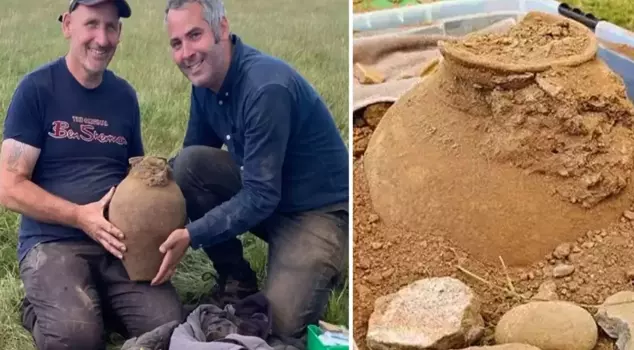
23.10.2025 18:32
David Moss and his friend, who were metal detecting for hobby purposes in Wales, discovered approximately 15,000 Roman coins in two pots buried underground. According to experts, this 2,000-year-old treasure has been recorded as the largest Roman period find ever discovered in Wales. As per royal law, the ownership of the artifact will pass to the state, while Moss and his friend's historical discovery will be rewarded.
```html
David Moss, who lives in the Cheshire region north of Wales, made a historical discovery during a metal detecting trip he took as a hobby with his friend Ian Nicholson.
THEY FOUND TWO POTS FILLED WITH COINS
The duo, who had not found any results during their searches throughout the day, experienced exciting moments when they received a signal from the detector just as they were about to lose hope. Starting to dig around the spot they found, Moss and Nicholson soon detected two clay pots about 30 centimeters underground. The pots were filled with thousands of bronze and silver coins from the Roman period.
"IT WAS BEYOND ANYTHING I COULD IMAGINE"
Describing those moments to the BBC, Moss said, "It was really a sign. We continued, and what emerged was beyond anything I could imagine." After carefully collecting the coins, he reported the find to local authorities. He then set off on a four-hour journey to the National Museum of Cardiff to hand over the treasure.
HE SLEPT IN HIS CAR FOR THREE NIGHTS TO PREVENT THEFT
After the discovery, Moss, worried about the coins being stolen, spent three nights in his car until the handover process was completed. Moss shared his feelings during those days, saying, "It was so valuable that I was afraid to even blink. It felt like I was sleeping in history."
THE LARGEST IN THE COUNTRY'S HISTORY
Anthony Halse, President of the South Wales and Monmouthshire Numismatic Society, announced that the coins found constitute the largest Roman treasure ever discovered in Wales. Experts estimate that the number of coins, which are believed to be around 2,000 years old, reaches 15,000.
THE INCOME WILL BE SHARED WITH THE LANDOWNER
According to the "Treasure Act" of 1996, such archaeological finds in Wales become the property of the Crown. However, according to the law, the discoverer and the landowner are financially rewarded. If the National Museum of Cardiff wishes to include the treasure in its collection, it will need to purchase it. In the event of a purchase, the income generated will be shared between David Moss and the landowner.
```